In-depth understanding of MySQL advanced drifting (3)
Function
Mathematical function
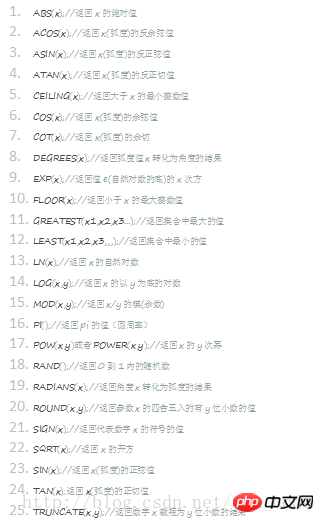
Requirements:
1)- The absolute value of 123;
2) Get the maximum value of 100,88,33,156; 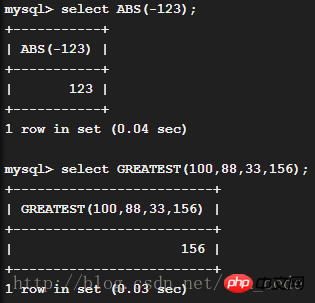
Aggregation function
MySQL has a set of functions specifically for summation or pairing Designed for centralized summary of the data in the table, these functions are often used in select queries containing group by clauses. Of course, they can also be used for queries without group
1) This group Among the functions, the most commonly used one is the COUNT() function, which calculates the number of rows in the result set that contain at least one non-null value
select count(*) from students;
2)MIN() and MAX() The function returns the minimum or maximum value of the number set
select min(score) from data; //Return the minimum value
select max(age) from data;Return the maximum value
Requirements:
New data table , the field is score, add two pieces of data, 29 and 34 respectively, to calculate the average and minimum value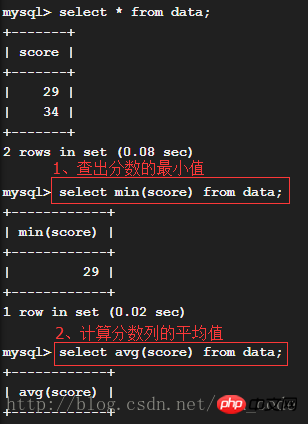
String function
MySQL database not only contains numerical data, It also contains strings, some commonly used ones are listed below:
The length of a string can be obtained through the length() function
select length('abcdefg');//The result is 7
Through the trim() function It allows us to specify the removal format when cutting values, and we can also decide to cut from the beginning, end, and both sides of the string.
select trim(' red hair');//Remove the spaces on both sides
select trim(leading '!' from '!!!heihei!!!');//Remove the first "!" symbol
The concat() function concatenates the provided parameters into a string
select concat('woyao','yaosini');//The result is woyaoyaosini
Date time function
1) Use the now() function to get the current date and time, which will be returned in the format of YYYY-MM-DD HH:MM:SS
select now();//Return the current time
2) To obtain the date and time separately, you can use the curdate() and curtime() functions
select curtime();//The current time, the format is HH:MM:SS
select curdate();//The current date, the format For YYYY-MM-DD
3) The week() function returns the week of the year for the specified date, and the yearweek() function returns the week of the year for the specified date
select week ('2017-02-24');//The result is 8
select yearweek(20170224);//The result is 200408
Encryption function (learn about it)
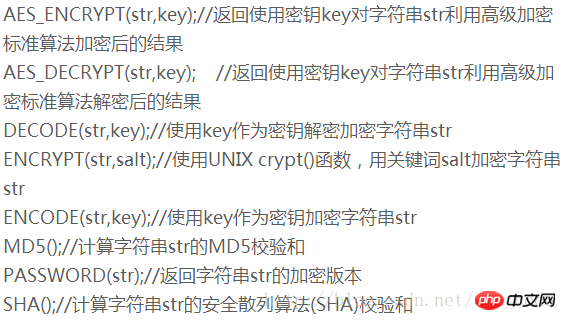
The password() function is used to create an encrypted password string, which is suitable for insertion into the MySQL security system. This encryption process is irreversible and uses a different algorithm than UNIX password encryption.
You can also use the UNIX crypt() system to encrypt strings through the ENCRYPT() function. The ENCRYPT() function receives the string to be encrypted and (optional) the salt (a character that can uniquely determine the password) used in the encryption process. string, like a key).
You can also use the ENCODE() function and DECODE() function to encrypt and decrypt strings. ENCODE() has two parameters: the encrypted string and the key as the basis for encryption;
Control Stream function
MySQL provides 4 functions for conditional operations. These functions implement the conditional logic of SQL, allowing developers to convert some application business logic to the database backend. 
The first of these functions is the ifnull() function, which has two parameters and judges the first parameter. If the first parameter is not null, the function returns the first parameter to the caller. If it is null, the second parameter is returned. 
The nullif() function will check whether the two provided parameters are equal. If they are equal, null will be returned. If they are not equal, the first parameter will be returned.
The if() function has three parameters. The first one is the expression to be judged. If the expression is true, the if() function will return the second parameter. If it is false, it will return the third parameter. The if() function is suitable to be used when there are only two results;
Format function
MySQL also has some functions specially designed for formatting data
The more commonly used function is the format() function, which can format large values into an easy-to-read sequence separated by commas. The first parameter of format() is the formatted data, and the second parameter is the number of decimal places in the result
Data conversion function
In order to perform data type conversion, MySQL provides the cast() function, which can convert a value into a specified data type
Normally, when using numerical operations, The string will be automatically converted into a number;
select 1+'99';//The result is 100
select 1+cast('99' as signed);//The result is 100
We can force Many date and time functions [including now(), curtime(), and curdate() functions] output the value they return as a number rather than a string. Simply use these functions in a numeric environment or convert them to Number
System information function
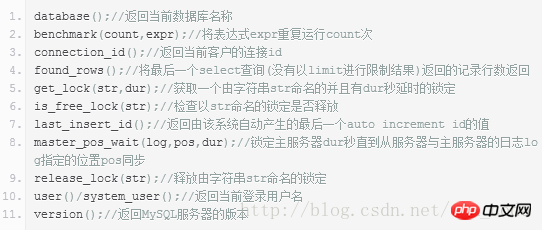
database(), user() and version() functions can respectively return the currently selected database and the current user And MySQL version information:
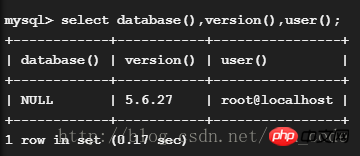
The above is the detailed content of In-depth understanding of MySQL advanced drifting (3). For more information, please follow other related articles on the PHP Chinese website!

Hot AI Tools

Undresser.AI Undress
AI-powered app for creating realistic nude photos

AI Clothes Remover
Online AI tool for removing clothes from photos.

Undress AI Tool
Undress images for free

Clothoff.io
AI clothes remover

AI Hentai Generator
Generate AI Hentai for free.

Hot Article

Hot Tools

Notepad++7.3.1
Easy-to-use and free code editor

SublimeText3 Chinese version
Chinese version, very easy to use

Zend Studio 13.0.1
Powerful PHP integrated development environment

Dreamweaver CS6
Visual web development tools

SublimeText3 Mac version
God-level code editing software (SublimeText3)

Hot Topics
 1386
1386
 52
52
 MySQL: Simple Concepts for Easy Learning
Apr 10, 2025 am 09:29 AM
MySQL: Simple Concepts for Easy Learning
Apr 10, 2025 am 09:29 AM
MySQL is an open source relational database management system. 1) Create database and tables: Use the CREATEDATABASE and CREATETABLE commands. 2) Basic operations: INSERT, UPDATE, DELETE and SELECT. 3) Advanced operations: JOIN, subquery and transaction processing. 4) Debugging skills: Check syntax, data type and permissions. 5) Optimization suggestions: Use indexes, avoid SELECT* and use transactions.
 How to open phpmyadmin
Apr 10, 2025 pm 10:51 PM
How to open phpmyadmin
Apr 10, 2025 pm 10:51 PM
You can open phpMyAdmin through the following steps: 1. Log in to the website control panel; 2. Find and click the phpMyAdmin icon; 3. Enter MySQL credentials; 4. Click "Login".
 MySQL: An Introduction to the World's Most Popular Database
Apr 12, 2025 am 12:18 AM
MySQL: An Introduction to the World's Most Popular Database
Apr 12, 2025 am 12:18 AM
MySQL is an open source relational database management system, mainly used to store and retrieve data quickly and reliably. Its working principle includes client requests, query resolution, execution of queries and return results. Examples of usage include creating tables, inserting and querying data, and advanced features such as JOIN operations. Common errors involve SQL syntax, data types, and permissions, and optimization suggestions include the use of indexes, optimized queries, and partitioning of tables.
 Why Use MySQL? Benefits and Advantages
Apr 12, 2025 am 12:17 AM
Why Use MySQL? Benefits and Advantages
Apr 12, 2025 am 12:17 AM
MySQL is chosen for its performance, reliability, ease of use, and community support. 1.MySQL provides efficient data storage and retrieval functions, supporting multiple data types and advanced query operations. 2. Adopt client-server architecture and multiple storage engines to support transaction and query optimization. 3. Easy to use, supports a variety of operating systems and programming languages. 4. Have strong community support and provide rich resources and solutions.
 How to use single threaded redis
Apr 10, 2025 pm 07:12 PM
How to use single threaded redis
Apr 10, 2025 pm 07:12 PM
Redis uses a single threaded architecture to provide high performance, simplicity, and consistency. It utilizes I/O multiplexing, event loops, non-blocking I/O, and shared memory to improve concurrency, but with limitations of concurrency limitations, single point of failure, and unsuitable for write-intensive workloads.
 MySQL and SQL: Essential Skills for Developers
Apr 10, 2025 am 09:30 AM
MySQL and SQL: Essential Skills for Developers
Apr 10, 2025 am 09:30 AM
MySQL and SQL are essential skills for developers. 1.MySQL is an open source relational database management system, and SQL is the standard language used to manage and operate databases. 2.MySQL supports multiple storage engines through efficient data storage and retrieval functions, and SQL completes complex data operations through simple statements. 3. Examples of usage include basic queries and advanced queries, such as filtering and sorting by condition. 4. Common errors include syntax errors and performance issues, which can be optimized by checking SQL statements and using EXPLAIN commands. 5. Performance optimization techniques include using indexes, avoiding full table scanning, optimizing JOIN operations and improving code readability.
 MySQL's Place: Databases and Programming
Apr 13, 2025 am 12:18 AM
MySQL's Place: Databases and Programming
Apr 13, 2025 am 12:18 AM
MySQL's position in databases and programming is very important. It is an open source relational database management system that is widely used in various application scenarios. 1) MySQL provides efficient data storage, organization and retrieval functions, supporting Web, mobile and enterprise-level systems. 2) It uses a client-server architecture, supports multiple storage engines and index optimization. 3) Basic usages include creating tables and inserting data, and advanced usages involve multi-table JOINs and complex queries. 4) Frequently asked questions such as SQL syntax errors and performance issues can be debugged through the EXPLAIN command and slow query log. 5) Performance optimization methods include rational use of indexes, optimized query and use of caches. Best practices include using transactions and PreparedStatemen
 Monitor Redis Droplet with Redis Exporter Service
Apr 10, 2025 pm 01:36 PM
Monitor Redis Droplet with Redis Exporter Service
Apr 10, 2025 pm 01:36 PM
Effective monitoring of Redis databases is critical to maintaining optimal performance, identifying potential bottlenecks, and ensuring overall system reliability. Redis Exporter Service is a powerful utility designed to monitor Redis databases using Prometheus. This tutorial will guide you through the complete setup and configuration of Redis Exporter Service, ensuring you seamlessly build monitoring solutions. By studying this tutorial, you will achieve fully operational monitoring settings




